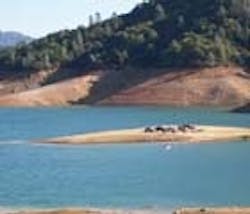California Officials Propose $9.3 Billion Water Bond for November Ballot
California Gov. Arnold Schwarzenegger and Senator Dianne Feinstein of California announced a proposal July 17 to address a severe water shortage in California by borrowing $9.3 billion to increase water storage, conveyance and conservation.
Their bond proposal requires voter approval, and needs a two-thirds majority vote of the Legislature to make it onto the ballot in November.
Schwarzenegger, a Republican, and Feinstein, a Democrat, touted the bipartisan nature of their plan. The parties have struggled over the years to find a way to satisfy demands for limited water resources.
"The goal of this plan is to break the long-standing stalemate over water," Feinstein said. "California is facing an unprecedented water crisis. The combination of drought, court-ordered water restrictions, global warming and an increasing population has placed a major strain on the existing infrastructure. We need to prepare now for the future."
"This language is comprehensive, balanced and could help increase water supplies to meet the needs of the environment, our cities and agriculture. I hope that all sides can come together around a consensus plan that can be approved this November," Feinstein said.
Shasta reservoir, a source of much of California's water, is currently at 42% of capacity.
"There is an urgent need for comprehensive water reform, and this bipartisan plan is offered as a potential compromise that puts us on the path toward restoring the Sacramento-San Joaquin Delta, expanding water supplies and promoting conversation efforts that will ensure a clean, reliable water supply for California," Schwarzenegger said.
"I know that legislative leaders recognize the urgent need to address California's water crisis, and I look forward to working with them to present a plan to voters this November," the governor said.
California Senate President pro tem Don Perata, an Oakland Democrat, proposed a $6.8 billion water bond last fall, but failed to win Legislative approval.
Since then, the state's budget crisis has worsened, facing a deficit of more than $15 billion in its 2008-09 budget.
To the Schwarzenegger/Feinstein plan, Perata offered qualified support. "The best way for the state of California to boost water supply quickly is to put the $9 billion in bond money approved by voters in 2006 to work," Perata said in a statement.
"I am open to doing a water bond. First, however, the state should spend the bond money voters approved in 2006, and then, we must pass a responsible budget that can pay for the debt service on a new bond," he said.
With the Sacramento-San Joaquin Delta ecosystem near collapse, court-ordered restrictions on water deliveries from the Delta have reduced supplies from the state's two largest water systems by 20% to 30%, the Governor's Office explains on the site. The court-ordered restrictions were imposed last year to keep a small fish, the Delta smelt, from going extinct.
"Drought conditions in the Colorado River Basin and a Sierra snowpack is now dangerously unreliable due to global warming and is leaving many communities throughout California facing mandatory restrictions on water use and/or rising water bills. If the drought continues into next year, the results could be catastrophic," the Governor's Office says.
Bond proponents presented an outline for how the money would be used:
• $3 billion dollars for water system operational improvement, including water storage projects. Improving water storage typically involves building or enlarging dams, but also may involve banking water in depleted aquifers;
• $2 billion dollars for water supply reliability, including conservation and improved connections within and between regions;
• $1.9 billion for the Sacramento-San Joaquin River Delta, including projects involving levees, water quality, infrastructure and ecosystem sustainability;
• $1.335 billion for conservation and watershed protection, including removing invasive species, restoring lands damaged by fires and removing dams to let fish pass;
• $800 million for protecting groundwater, including wastewater treatment for small communities, managing storm water and improving quality of coastal water; and
• $250 million for recycling water.
Source: Environment News Service
